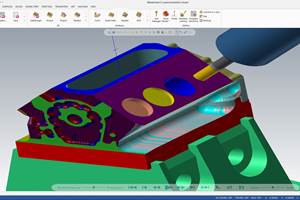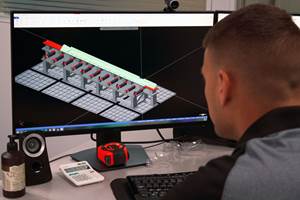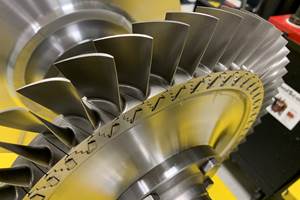Setting The Stage For Production
This software is an external verification/optimization tool that provides faithful representations of first-run machining processes. This affords the opportunity to rectify machining conflicts before the first chip flies.
The conventional response to a machining error is to diagnose the cause after the damage is done. But this approach entails some key drawbacks. In the first place, delays or disruptions in production represent the most costly events that occur in machine shops. The attendant costs of ruined cutting tools, damaged spindles or scrapped parts also represent major concerns.
Given these risks, using software tools to simulate actual machining operations represents a distinct advantage in process management. Performing dress rehearsals for metalworking's main events is precisely the capability provided by Vericut verification/optimization software manufactured by CGTech (Irvine, California).
The verification functions embedded in many CAD/CAM systems check only the internal CAM files. Because these files may be subject to additional translation before reaching the machine controls, errors can sometimes creep into the process. Vericut is an external verification/optimization tool that provides faithful representations of first-run machining processes. This affords the opportunity to rectify machining conflicts before the first chip flies.
Because the program's simulations are driven by the same control logic and data that drive machine tools, virtual prove-outs conform precisely to the actual machining. Thus, a virtually machined "part" may be compared for conformance to the original design model before any metal is cut. The virtual "as-machined" CAD model may also be exported back to the CAD system for other uses such as designing mated parts or planning subsequent operations.
The Vericut software package comprises seven add-on modules that run on Windows and UNIX platforms. These modules allow users to customize packages to serve specific needs. For example, the OptiPath module allows the feed rates to be adjusted to suit the changing cutting conditions for more efficient tool paths. A separate Auto-Diff module enables the user to virtually embed the design model (including tolerance offsets) within the raw stock. If the virtual tool broaches this tolerance envelope, the program automatically reports the error and highlights the gouge.
The Machine Simulation module creates and operates virtual machine tools and controls. In addition to the features offered in the software's 5.1 version, CGTech has developed Vericut 5.2 with new and enhanced capabilities. The software incorporates a review function that allows the user to replay either the entire tool path or only a particular segment. This enables the user to review critical portions of the tool path, as well as to display the cutting tool at the precise location of the error. During this process, the NC program code (G-code or APT file) is displayed beside the graphics. This enables the user to edit the NC program on the fly as the virtual prove-out continues.
Other improvements in the 5.2 version are a new Mastercam interface and an enhanced Unigraphics interface. The interfaces allow tool paths to be verified at the same time that the user continues to work in these programs. Besides simulating and verifying milling, turning, drilling, mill/turn and wire EDM tool paths, the new version adds a die-sinking function. This function checks for electrode gouges and over- or under-burn conditions. It also analyzes the volume of material removed by each electrode, the contact area and electrode overlaps.
In addition to upgrading existing Vericut functions, the 5.2 version also simulates turn-threading operations and supports boring bar cycles. A new Comparator function enables users to overlay circular or rectangular grids onto the cut model for quick visual measurements. The program's Curve Fitting function reads NC programs to detect sequences of planar motion, thereby fitting arcs to smooth linear motion. This "pre-processor" helps to improve surface finishes and reduce machining time.
By simulating, verifying and optimizing their production processes, machine shops can reduce the time and expense that accompany a trial-and-error approach. Furthermore, using virtual dry runs to test part programs ensures that the first runs will be successful.
Related Content
When to Use Custom Macros With a CAM System
Custom macros can offer benefits even when using a CAM system to prepare programs – but must be implemented with the right considerations.
Read MoreCAD/CAM System Requirements: An Overview
CAD/CAM programs are among the most demanding kinds of computer software. Smooth operation requires careful consideration of computer specifications.
Read MoreLarge-Format Machining With Small Cutting Tools and Dynamic Motion
Napoleon Machine, a defense contractor that provides parts for the M1 Abrams tank, recently took advantage of a CAM feature that allowed the company to streamline its cutting strategies and program offline. Here’s how the shop cut cycle times nearly in half with its large-format five-axis machining operations.
Read MoreIntegrated CAD/CAM Promotes Process Efficiency, Traceability
High-requirement markets are not only searching for good parts — they're searching for proof of good parts. CAD/CAM software can help.
Read MoreRead Next
3 Mistakes That Cause CNC Programs to Fail
Despite enhancements to manufacturing technology, there are still issues today that can cause programs to fail. These failures can cause lost time, scrapped parts, damaged machines and even injured operators.
Read MoreThe Cut Scene: The Finer Details of Large-Format Machining
Small details and features can have an outsized impact on large parts, such as Barbco’s collapsible utility drill head.
Read More



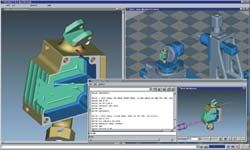
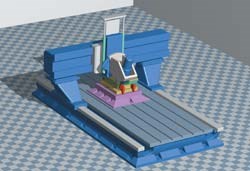










.png;maxWidth=300;quality=90)



.png;maxWidth=300;quality=90)

